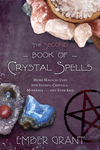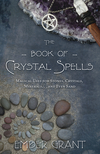Fire Quartz Magic

In the practice of crystal magic, few would argue about the importance of quartz. Since it's one of the most abundant minerals on earth, and it can be found in so many varieties, there's bound to be some confusion when distinguishing among the different types. Fire Quartz is a prime example of this difficulty. It is a reddish-orange quartz, but there are so many variations of color and pattern that many different names have been created to describe it. You may know it as Harlequin Quartz, Red Quartz, Tangerine Quartz, Strawberry Quartz, Hematoid, or Ferruginous Quartz. These are all essentially just slight variations of the same type of quartz—quartz with inclusions (or sometimes coatings) of iron.
Here's the first point of confusion: which type of iron is included in the quartz? First, there's hematite—the main ore of iron—which ranges in appearance from black to silvery-gray to red. Then there's the mineral goethite, another mineral that contains iron (goethite is a component of rust); it can be formed by the weathering of other minerals. And, to add to the confusion, there's also the mineral limonite. Limonite is actually not a true mineral but a combination of minerals. It can give quartz a yellowish-brown color. Much of what is called limonite is actually goethite. Like goethite, it's a pseudomorph (again, due to environmental changes such as weathering, exposure to water, etc.). Limonite is what gives Golden Healer Quartz its color–inclusions within the crystal make it look yellow (not to be confused with Citrine Quartz). Some sources say there can also be a golden-colored coating on the stone’s surface. And, finally, lepidocrocite is yet another iron oxide mineral, red to reddish-brown. Mindat.org (the Hudson Institute of Mineralogy) says that usually when red is found in clear quartz it's typically goethite or hematite; it's actually rare to find lepidocrocite in clear quartz.
Now for the name confusion. You may see the word ferric (or ferrous) used to refer to iron in quartz. This term is often used to denote minerals containing iron (the specific distinction of the type of iron is not necessary for the scope of this article). Typically, the classification of the different types of iron refers to the iron's oxidation number, and iron has many states of oxidation (loss of electrons in an atom). The term "hematoid" comes from the name of the mineral hematite. Metaphysical terms like "harlequin," "fire," "red," "tangerine," and "strawberry" have arisen due to the appearance of the stone.
So, what's the difference? Since it may be difficult to determine exactly which iron ore inclusions are present in the stone, the name you use may depend on the crystal's appearance.
Fire Quartz (or Red Fire Quartz) is, quite simply, quartz with inclusions of hematite and/or goethite. (Additionally, amethyst with iron inclusions is typically called "red" amethyst.) Fire Quartz is the name for stones that are almost completely filled with inclusions of red, brown, and orange. If you have a piece of clear quartz with only a few red (and/or silver-gray) blotches, threads, or markings, it is Harlequin Quartz. Strawberry Quartz tends to have a more opaque appearance and actually looks pink in color. Sometimes this term is used to refer to both Fire and Harlequin Quartz, adding to the confusion. And then there's Tangerine Quartz, which is orange to reddish-orange in color and is sometimes called Red Quartz. This type may have a rough coating over all or part of the crystal’s surface.
Here is how I break it down: Strawberry Quartz is pale red to pink (not to be confused with Rose Quartz), and it is translucent or opaque (not typically transparent). Harlequin Quartz is transparent (or nearly transparent) clear quartz with a few red, reddish brown, gray, or pinkish blotches or thread-like markings. Fire Quartz is so filled with iron inclusions that it has very few transparent areas. It's typically a mixture of very deep red-brown with possibly some orange. Tangerine Quartz ranges in shades of pale to dark orange; when the shade is deeper, tending toward red, then it’s called Red Quartz. Naturally, there will be sources that disagree with my categorization. When in doubt, use your intuition.
Now that you know the varieties, the next step is usage. This, thankfully, is somewhat simple. For metaphysical purposes, iron means strength. Iron is a very important metal in our world—for human use, biology, and in the environment. The type of strength you seek is where the subtle differences in the crystals' metaphysical properties can be useful. Harlequin Quartz can be used for overcoming difficult situations, achieving balance, and assisting with transitions. It has a gentle, uplifting energy. Red Quartz increases vitality and physical energy, while also promoting action. Strawberry Quartz energizes the heart chakra, assists with balancing, and can foster a euphoric, loving state of mind. Tangerine Quartz can be used for healing and rejuvenation. Fire Quartz promotes strength and physical energy, especially when directed toward one's passions. In a pinch, each of these can probably be used interchangeably, with the possible exception of Strawberry Quartz (which is actually somewhat rare).
The best feature of these stones is that they all promote change and transformation coupled with strength and stability. These crystals can be magical powerhouses. Here's why. First of all, iron is associated with the Element of Fire, which governs desire, change, and transformation. In addition, iron has a cubic structure, which corresponds to the Earth Element and stability. Iron is a transition metal or transition element (a chemistry term); basically, these elements are special because they can form many different compounds, have high boiling and melting points, and can conduct electricity. If we look at these descriptions as a "personality," it reveals being adaptable, being able to withstand intensity, and the ability to channel or communicate. All valuable qualities! And, to add to the dynamic qualities of this stone, the trigonal structure of quartz corresponds to the tetrahedron Platonic Solid, which is related to the Element of Fire.
Here's a spell you can use to transform a passion or desire into a tangible reality. It calls for Fire Quartz, but feel free to use Harlequin, Red, or even Tangerine Quartz, if that's all you have available.
Fire Quartz Manifestation Spell
To manifest something means to outwardly express it or make it visible. This spell can help you manifest a goal or wish, and bring it into reality. Fire Quartz is used for this spell because it taps into the Element of Fire for transformation, and utilizes the iron content of the stone for strength and stability during the change. Fire is also the Element associated with passion. Make your passion a reality.
What do you desire? Finding your dream house or dream job? Perhaps you dream of traveling the world, or successfully completing a large project. Just remember: you must be ready for the change as well as the challenges it presents; it could be a dramatic (and unpredictable) process.
Hold the stone in your projective hand. Visualize yourself having achieved your goal. See it actually happening. Next, state your goal aloud as you write it on a piece of paper; fold the paper and place your Fire Quartz stone on top of it. Create a circle of red (or white) candles around the stone and paper. Alternately, use one large red or white candle and place it near the stone and paper. Light the candle(s) and chant:
Spark and sparkle, stone and fire,
Know my truest heart's desire.
Focus action on my passion,
Make it real, make it happen.
For good of all and harm to none,
As I will, it shall be done.
Allow the candle(s) to burn out. Carry the stone with you whenever you can, especially when involved in tasks related to your goal; otherwise, place it where you can see it each day.
About Ember Grant
Related Products


is subject to certain Terms and Conditions